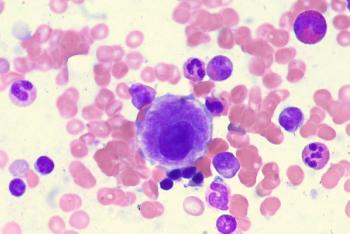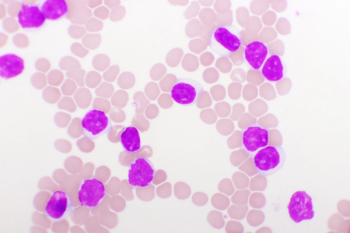
Leukemia
Latest News

Latest Videos

More News

Patients with chronic lymphocytic leukemia treated with fixed duration venetoclax/rituximab may experience prolonged disease control vs bendamustine/rituximab.

Two-year overall survival increased from period between 2000 and 2004 to period between 2015 and 2019 for patients with Philadelphia chromosome-positive acute lymphoblastic leukemia who relapsed after allogeneic hematopoietic stem cell transplantation.

A pooled analysis indicated that patients who were 80 years or older had efficacious responses to targeted therapies for chronic lymphocytic leukemia regardless of coexisting conditions and organ dysfunction.

The combination of acalabrutinib, with or without obinutuzumab, produced a strong survival benefit for patients with treatment-naïve chronic lymphocytic leukemia over treatment with ibrutinib or venetoclax plus obinutuzumab.

Treatment with CA-4948 monotherapy yielded positive safety data and efficacy for patients with relapsed/refractory acute myeloid leukemia and myelodysplastic syndrome; CI-8993 also appeared to show promise in patients with relapsed/refractory solid tumors.

CD123- and CD3-engaging bispecific antibody, APVO436, caused cytokine release syndrome that could be managed through the use of steroids in patients with relapsed/refractory acute myeloid leukemia and myelodysplastic syndrome.

CYNK-001 was recently granted fast track designation by the FDA for the treatment of patients with acute myeloid leukemia.

Preclinical evidence supports further research in combining a menin inhibitor plus targeted therapies, as this may result in superior efficacy for patients with KMT2A-rearranged and NPM1-mutated acute myeloid leukemia.

Susan M. O’Brien, MD, on why clinical trial enrollment is so important for patients with chronic lymphocytic leukemia.

A cohort study did not identify strong associations between outpatient or inpatient neutropenia management and increased bacteremia incidence, treatment delays, or worse health-related quality of life for pediatric patients with acute myeloid leukemia.

A non inferiority design was presented at ASH 2021 for acalabrutinib plus venetoclax in treatment-naive chronic lymphocytic leukemia or small lymphocytic leukemia.

Susan M. O’Brien, MD, highlights ongoing trials from 2021 examining combination therapies for patients with chronic lymphocytic leukemia.

Matthew S. Davids, MD, spoke about which abstracts presented at ASH 2021 he felt were most important.

Susan M. O’Brien, MD, discusses novel mechanisms of action and BTK inhibitors for patients with chronic lymphocytic leukemia.

Lindsey Roeker, MD, spoke about data presented at ASH 2021 and what she thought to be most interesting.

Susan M. O’Brien, MD, on common toxicities and adverse effects when treating patients with chronic lymphocytic leukemia.

CancerNetwork® reflects on developments in the chronic lymphocytic leukemia space throughout 2021 and potential future events that may take place in 2022 with Matthew S. Davids, MD, MMSc.

Jennifer A. Woyach, MD, spoke about why it’s important to use newer therapies instead of chemoimmunotherapy for patients with chronic lymphocytic leukemia.

Susan M. O’Brien, MD, on combination therapies for treating patients with chronic lymphocytic leukemia.

Susan M. O’Brien, MD, on treating patients with 17p deletions and TP53 mutations who have chronic lymphocytic leukemia.

Susan M. O’Brien, MD, on the approved BTK inhibitors for treating chronic lymphocytic leukemia.

Maintenance oral azacitidine produced a sustained survival benefit over placebo for patients with acute myeloid leukemia in first remission.

Susan M. O’Brien, MD, discussed the emergence of noncovalent BTK inhibitors for treating chronic lymphocytic leukemia.

Jennifer A. Woyach, MD, spoke about the results of a study conducted in elderly patients treated with an ibrutinib-containing regimen for chronic lymphocytic leukemia at 55 months of follow-up.

The combination of high-frequency and low-dose acalabrutinib and rituximab demonstrated a 100% overall response rate in patients with chronic lymphocytic leukemia/small lymphocytic lymphoma.




















































































